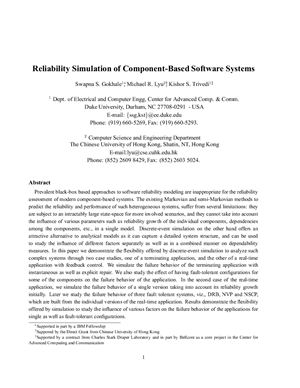Paper - 21 p
Prevalent black-box based approaches to software reliability modeling are inappropriate for the reliability assessment of mode component-based systems. The existing Markovian and semi-Markovian methods to predict the reliability and performance of such heterogeneous systems, suffer from several limitations: they are subject to an intractably large state-space for more involved scenarios, and they cannot take into account the influence of various parameters such as reliability growth of the individual components, dependencies among the components, etc. , in a single model. Discrete-event simulation on the other hand offers an attractive alteative to analytical models as it can capture a detailed system structure, and can be used
to study the influence of different factors separately as well as in a combined manner on dependability measures. In this paper we demonstrate the flexibility offered by discrete-event simulation to analyze such complex systems through two case studies, one of a terminating application, and the other of a real-time application with feedback control. We simulate the failure behavior of the terminating application with instantaneous as well as explicit repair. We also study the effect of having fault-tolerant configurations for some of the components on the failure behavior of the application. In the second case of the real-time application, we simulate the failure behavior of a single version taking into account its reliability growth initially. Later we study the failure behavior of three fault tolerant systems, viz. , DRB, NVP and NSCP, which are built from the individual versions of the real-time application. Results demonstrate the flexibility offered by simulation to study the influence of various factors on the failure behavior of the applications for
single as well as fault-tolerant configurations.
Prevalent black-box based approaches to software reliability modeling are inappropriate for the reliability assessment of mode component-based systems. The existing Markovian and semi-Markovian methods to predict the reliability and performance of such heterogeneous systems, suffer from several limitations: they are subject to an intractably large state-space for more involved scenarios, and they cannot take into account the influence of various parameters such as reliability growth of the individual components, dependencies among the components, etc. , in a single model. Discrete-event simulation on the other hand offers an attractive alteative to analytical models as it can capture a detailed system structure, and can be used
to study the influence of different factors separately as well as in a combined manner on dependability measures. In this paper we demonstrate the flexibility offered by discrete-event simulation to analyze such complex systems through two case studies, one of a terminating application, and the other of a real-time application with feedback control. We simulate the failure behavior of the terminating application with instantaneous as well as explicit repair. We also study the effect of having fault-tolerant configurations for some of the components on the failure behavior of the application. In the second case of the real-time application, we simulate the failure behavior of a single version taking into account its reliability growth initially. Later we study the failure behavior of three fault tolerant systems, viz. , DRB, NVP and NSCP, which are built from the individual versions of the real-time application. Results demonstrate the flexibility offered by simulation to study the influence of various factors on the failure behavior of the applications for
single as well as fault-tolerant configurations.

